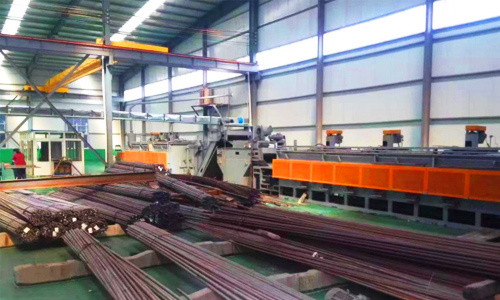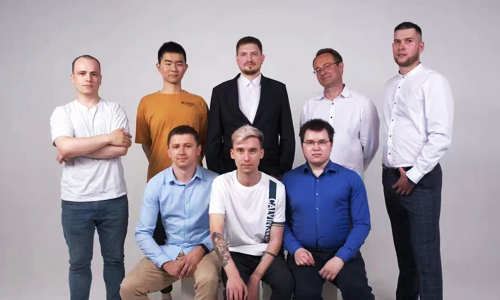Direction of localization of steel for automotive fasteners
Release time:
2023-01-30 15:36
Direction of localization of steel for automotive fasteners
Abstract: The performance requirements, smelting and rolling characteristics of steel for automotive fasteners are introduced; The current situation and development direction of relevant clean bolt steel, microalloyed non-quenched and tempered steel, non-annealed steel, boron steel, and high strength steel resistant to delayed fracture are described; The direction of efforts to implement the localization of steel for automobile fasteners is pointed out.
According to the statistics of China Automobile Industry Association in January 2010, China's automobile production and sales in 2009 were 1379 100000 and 13644800 vehicles, up 48% and 46% respectively year on year. The rapid development of the automobile industry has increased the demand for steel materials. Although China has been the world's largest steel producer for many years, the steel used for automobile engine and key parts fasteners is still mainly imported products due to the strength limitation. At the same time, the development trend of high-performance and lightweight automobile has put forward higher requirements for the design stress and lightweight of automobile fasteners, High-strength steel for fasteners is the most effective way to solve this requirement.
1. Performance requirements of steel for automotive fasteners
Requirements for steel for automotive fasteners:
(1) Good surface quality, high dimensional accuracy and low non-metallic inclusions and segregation;
(2) It has high tensile strength and good cold heading performance;
(3) It has high fatigue resistance and multiple impact tensile resistance;
(4) It has sufficiently low delayed fracture sensitivity and low ductile-brittle transition temperature.
2. Smelting and Rolling Characteristics of Steel for Automobile Fasteners
2.1 Smelting technology
The continuous casting process with external refining and electromagnetic stirring is adopted. It is mainly to control the composition of main elements such as C, Si, Mn, Cr, Mo in the steel to a small range, and reduce the content of impurities such as P, S, 0, N in the steel as much as possible to achieve the purpose of high purity of steel, low non-metallic inclusions and low segregation level, so as to improve the cold heading property of steel and improve the surface quality of steel.
2.2 Rolling technology
High-speed and high-precision rolling process with controlled milking and controlled cooling functions is adopted to obtain rolled heat-treated wire rod (without quenching and tempering or annealing), and make it have good dimensional accuracy (without drawing treatment) and as few surface defects as possible (without peeling).
3. Current situation and development direction of steel for automotive fasteners
3.1 Clean bolt steel
In terms of improving the cold heading property and quality of steel, it is necessary to reduce the content of impurity elements in steel as much as possible. Reducing S content can improve the deformation ability of steel, reduce non-metallic inclusions in steel and improve toughness and plasticity; The reduction of P content can reduce the deformation resistance of the steel, and the reduction of P and S content can also reduce its segregation at the grain boundary, reduce the grain boundary embrittlement, and improve the delayed fracture resistance of the steel; Reducing the content of 0 in steel can effectively reduce the oxide inclusions, thus improving the cold working deformation ability of steel.
The General Institute of Iron and Steel Research has studied the stress corrosion threshold stress intensity factor KISCC of ML42CrMo steel with high cleanliness. The KISCC of steel with high cleanliness is significantly higher than that of commercial steel. Therefore, in order to ensure that the steel still has high comprehensive properties after high strength, the content of P and S of high-strength bolt steel should be further reduced.
3.2 Economic high-strength bolt steel
3.2.1 Microalloy non-quenched and tempered steel
Using microalloyed non-quenched and tempered steel to make bolts can omit the spheroidizing annealing before cold drawing and quenching and tempering treatment after bolt forming, reduce the decarburization tendency of threaded threads, improve the yield of bolts, and have obvious economic benefits.
The commonly used microalloying elements of microalloyed non-quenched and tempered steel include Ti, Nb, V, B, etc. During the heating process before milking, it is necessary to ensure that the microalloyed elements are fully dissolved, and then the dispersed fine microalloyed element carbonitride is precipitated during the control of milking and cooling process to inhibit the growth of austenite grains and obtain fine grains, which can improve the strength and toughness of steel at the same time. It is worth mentioning that B, a small amount of B can significantly improve the hardenability of steel and significantly delay the pearlite transformation. Combined with low temperature rolling, it is beneficial to increase the ferrite content, thus improving the cold heading performance of steel. The main role of microalloyed elements in steel is shown in Table 1.
The microstructure of microalloyed non-quenched and tempered steel is low carbon manganese ferrite+pearlite and bainite. Due to the role of microalloyed elements in refining grains and the dispersion of carbon and nitride strengthening phases in ferrite and pearlite, the steel can obtain the mechanical properties of medium carbon steel after quenching and tempering without quenching and tempering after rolling. The microalloyed non quenched and tempered steel is mainly used to process Grade 8.8 high-strength bolts. The steel grades that have been applied at home and abroad include: Kobe KNCH8S, Sumitomo Metal SUC80, LF10MnSiTi, LF20Mn2, LF18Mn2V in Chinese Mainland, and MFT8 produced by Masteel. A small number of grade 10.9 stud bolts are made of microalloyed non-quenched and tempered steel. However, for higher strength grades, such as high-strength bolts of grade 12.9, there is no example of using microalloyed non-quenched and tempered steel to manufacture.
By rolling at the temperature of the two-phase zone, the cold-work-strengthened non-quenched and tempered steel is developing from microalloying to deformation-induced ultra-fine structure. The production of wires and bars that can be used for cold heading of high-strength fasteners with steel without or without microalloying elements can not only save resources and energy, but also protect the environment. Therefore, the development of energy-saving and environment-friendly steel production technology for high-strength fasteners, It is the development direction of wire rod and bar production technology in the near future and even in the future.
3.2.2 Anneal-free medium carbon steel or medium carbon alloy steel
The steel delivered in the ordinary hot-rolled state often needs to be spheroidized first to meet the requirements of cold-drawn forming. Its purpose is to make the flaky carbide (cementite) in the microstructure of the steel spherical through spheroidizing annealing, so as to obtain the material with low deformation resistance and excellent plasticity. The non-annealing medium carbon steel or medium carbon alloy steel is to make the spherical cementite precipitate directly from the undercooled austenite under certain conditions. The research shows that the precipitation of cementite from the parent phase in the form of lamellar form during the transformation from austenite to pearlite is a metastable state, and there is a tendency of spontaneous transformation to spherical cementite with more thermodynamic stability in theory. For this reason, Wu Fan et al. also measured the activation energy required for the transformation of lamellar cementite into spherical cementite.
It is impossible for stable spherical cementite to precipitate from stable austenite. According to the research, the deformation of low carbon steel slightly higher than Ar3 under high strain rate and large strain can obtain 2 μ The ultra-fine ferrite below m has an impact on the decomposition mode of the surrounding untransformed austenite, which is characterized by the accelerated transformation and slow coarsening of austenite into degenerated pearlite during subsequent cooling or annealing. For medium carbon steel with high pearlite content, the non-equilibrium of austenite can be achieved by controlled rolling, and then the spheroidal cementite instead of lamellar cementite can be obtained by subsequent controlled cooling, thus realizing online softening treatment.
The traditional high-speed wire rod mill is difficult to realize online softening treatment because it can not carry out controlled rolling with low temperature and large deformation and the controlled cooling line is too short.
In 1999, the 7th Wire Rod Plant of Kobe Steel Co., Ltd., Japan, revamped the equipment, added the reducing and sizing unit with super-heavy capacity, and increased the Stelmo air-cooled transportation line from 48 m to 100 m. In 2001, the revamped wire rod mill successfully achieved online softening treatment, and the strength of the SCM435 cold heading steel wire rod produced was below 800 MPa, lower than the traditional 900 MPa.
The online softening treatment process of high strength cold heading steel at Maanshan Iron and Steel Co., Ltd. was studied earlier in China. The users of SWRCH35K - M non-annealing steel produced by Maanshan Iron and Steel Co., Ltd. can directly carry out drawing and cold heading production. The high-speed wire rod production line of Anyang Steel Plant adopts Morgan 6th generation rolling technology, and the length of Stelmore air-cooled transportation line is 105 m. After years of exploration, the SCM420-440 series of high-strength cold heading steel produced has also reached the effect required by the online softening treatment process. Taking SCM435 as an example, its total mass fraction of electrolytic inclusions is 0.0058% on average, its central porosity and central shrinkage are 0.5, and its hot-rolled structure is mainly ferrite+pearlite, The total depth of decarburization layer is less than 0.15 mm, φ The grain size grade of wire rod of 6.5~16mm is above grade 8, and the hardness HRB value is about 90. Users can implement a simplified annealing process of 9 hours, which reduces the processing time by more than 2/3 compared with the spheroidizing annealing process of more than 30 hours.
3.2.3 Boron steel
Characteristics of boron steel:
(1) It has good cold deformation ability and can eliminate annealing treatment before cold deformation;
(2) The brittleness tendency of quenching is low, which can be quenched with water;
(3) The addition of trace boron can partly replace the addition of expensive alloying elements;
(4) The delayed fracture sensitivity of low carbon steel is relatively low.
The basic principle of boron steel composition design is to reduce the carbon content and improve the cold deformation ability of steel; Add trace boron with a mass fraction of 0.0005%~0.0035% to compensate for the loss of strength and hardenability caused by carbon reduction. In addition, Cr, Mn, Ti and other alloy elements can be added as needed to further improve the hardenability.
Generally, Grade 8.8 bolts are made of low carbon manganese boron steel equivalent to SAE10B23, Grade 9.8 and 10.9 bolts are made of medium carbon manganese boron steel equivalent to SAE10B35, or ML35MnB and ML370B boron steel equivalent to ML40Cr and ML35CrMo. However, the tempering temperature of boron steel is 60~80 lower than that of SCM435 and ML40Cr due to its low tempering softening resistance, so the delayed fracture sensitivity of grade 10.9 high-strength bolts made of boron steel is high.
The way to solve this problem in China is to improve the comprehensive mechanical properties of boron steel by increasing the content of V in boron steel and reducing the content of P, S and C. In 1992, ML15MnVB and ML20MnVB steels were successfully developed in China and listed in GB/T 6478-2001 Steel for Cold Heading and Cold Extrusion. They are used to manufacture engine connecting rod bolts, cylinder head bolts and high-strength bolts for motorcycles. They are of excellent quality. The delayed fracture resistance within the tensile strength range of 1000~1200MPa is equivalent to or better than SCM435 steel.
Japan Datong Special Steel has recently developed a 10.9 grade delayed fracture resistant steel for bolts. Its composition is: w (C)=0.25%, w (Si)=0.03%, w (Mn)=1%, w (P)=0.01%, w (S)=0.002%, w (Cr)=0.3%, w (Ti)=0.05%, w (Nb)=0.025%, w (B)=0.002%. The rolled structure is ferrite+pearlite with low hardness. Due to the reduction of the content of impurity elements P and S, and the addition of Ti and Nb, the grain is refined, The delayed fracture resistance of this steel in the strength range of 1000-1300 MPa is equivalent to or better than that of SCM435 steel, and has been used to manufacture 10.9 grade automobile bolts.
The domestic Anyang Steel Plant has also successfully developed and produced 10B21 series boron steel according to the American standard, and its w (N) is 0.0022% - 0.0054%, with an average value of 0.0038%; W (0) is 0.0016% - 0.0036%, with an average value of 0.0028%. The hot-rolled structure is ferrite+pearlite, the total decarburization depth is less than 0.15 mm, the wire rod grain size grade is above 8, and the qualified rate of 1/2 cold upset forging is 100%. However, during continuous casting and billet drawing, this steel sometimes has dense corner small transverse cracks, and the corresponding wire rod surface has a large number of scabs, and the yield is not high. Therefore, it is still time for the large-scale production of 10B21 series boron steel in Anyang Steel Plant.
3.2.4 High strength steel resistant to delayed fracture
Delayed fracture refers to the sudden brittle failure of a material under static stress after a certain period of time. It is an environmental embrittlement caused by the interaction of material, environment and stress, and a form of material deterioration caused by hydrogen. When the strength exceeds 1200MPa, the delayed fracture of high-strength bolt steel becomes very prominent, and the accidents caused by it occur frequently. Therefore, the development of high strength bolt steel with resistance to delayed fracture is one of the research hotspots at home and abroad in recent years.
High-strength bolts are mostly made of tempered martensite, which is more sensitive to delayed fracture. Considering the influence of structural factors on the delayed fracture resistance of high-strength bolts, appropriate isothermal treatment process can be adopted to obtain the duplex structure of lower bainite and appropriate amount of martensite and residual austenite, and the high strength of martensite and the good delayed fracture resistance of bainite and austenite can be used to achieve good delayed fracture resistance under high strength. Or the fine martensite without grain boundary or with less grain boundary carbides can be obtained by proper heat treatment process, which can also have good delayed fracture resistance.
The following measures are often taken in the development of delayed fracture resistant steel at home and abroad.
(1) Reduce grain boundary segregation. The content of impurity elements P and S shall be reduced as much as possible, while the content of Mn shall be reduced to prevent grain boundary embrittlement (P reduces the bonding strength of grain boundary, S promotes the absorption of hydrogen in corrosive environment, and Mn is liable to cause P and S co-segregation).
(2) Refine grains. The addition of Ti, Nb, V, Al and other elements will produce dispersed precipitated carbonitrides to refine austenite grains, improve strength and improve paving.
(3) Increase tempering temperature. Add elements such as Mo and V with strong tempering and softening resistance to raise the tempering temperature to avoid the tempering temperature zone that is easy to cause grain boundary embrittlement, and make the carbide fine and uniform.
(4) Adjust alloy elements. Such as adding Ni and reducing Mn to obtain higher notch toughness.
(5) Minimize the amount of hydrogen penetrated into the steel surface, that is, add alloy elements such as Mo that inhibit the formation of corrosion pits.
(6) Make the invaded hydrogen harmless. Add appropriate amount of microalloying elements Ti, Nb, V to form fine carbonitrides, so as to uniformly distribute hydrogen and inhibit the diffusion of hydrogen.
In recent years, a series of high-strength bolt steels with excellent delay fracture resistance have been successfully developed at home and abroad, such as the ADS series of Sumitomo Metal in Japan and the KNDS series of Kobe Iron. All of them obtain high strength and excellent delay fracture resistance by adding microalloyed elements and adjusting their content and proportion. Their use effects are significantly better than those of SCM440 steel. Under the guidance of the General Institute of Iron and Steel Research, Dalian Steel Works of China has successfully developed a 1300 MPa high strength bolt steel 42CrMoVNb (ADF1) based on 42CrMo steel by reducing the content of S, P, Si and Mn. Its comprehensive mechanical properties have been greatly improved. The 13.9~14.9 grade high strength bolts have been used in Iveco and Cummins engines.
4. Conclusion
The rapid development of China's automobile industry has brought huge market opportunities to domestic steel for automotive fasteners, and the high strength of steel for automotive fasteners has become an inevitable trend of market development. Conditional Chinese steel enterprises should speed up the research and development and production of steel for automotive fasteners, learn from the advanced production processes and achievements at home and abroad, and improve the localization rate of steel for automotive fasteners.








 sales1@sg-fastener.com
sales1@sg-fastener.com
 86-0531-83865999
86-0531-83865999
